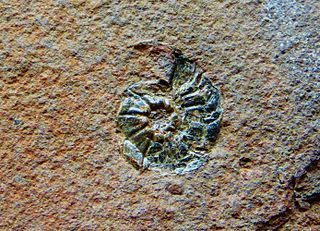Related Research Articles
Nannites is a genus in the ammonoid cephalopods in the order Ceratitida from the middle and upper Triassic of the Alps, named by Mojsisovics (1897). Nannites is the type genus of the Nannitidae which has been placed in the Danubitaceae. Previously the Nannitidae was included in the Ptychitaceae along with the Ptychitidae and, Isculitidae.
Abichites is ceratitid genus, assigned to the family Dzhulfitidae, from the Upper Permian of Armenia, Azerbaijan, and Iran, with three species recognized: A. abichi, A. mojsisovicsi, and A. stoyanowi.
Xiphogymnites is an extinct ammonoid cephalopod genus from the Triassic included in the family Gymnitidae. It is known from the Balkans in eastern Europe.

Asklepioceras is a genus in the Ceratitid family Arpaditidae from the Middle and Upper Triassic of Italy, Romania, Turkey, and British Columbia (Canada).
Anderssonoceras is a genus of small, smooth ammonites with a flared umbilical shoulder, like Prototoceras, assigned to the ceratitid family Anderssonoceratidae as the type, but once included in the Otoceratidae.
Arctogymnites is a genus of ammonoid cephalopods from the middle Triassic included in the ceratitid subfamily Beyrichitinae. Related genera include Beyrichites, Frechites, Gymnotoceras, and Salterites
Arctohungarites is a genus of Triassic ammonoids now placed in the ceratitid family Danubitidae, but previously included in the Hungeritidae.
Badiotites is a genus of extinct ammonoid cephalopods belonging to the ceratitid family Badiotitidae. It was previously included with Lecanites in the Lecanitidae, a family formerly of the Clydonitaceae but reassigned by Tozer (1981) to the Danubitaceae. The Badiotitidae is included in the Ceratitaceae.
Bacchites is a genus of extinct ammonoid cephalopods belonging to the ceratitid family Juvavitidae.
Dobrogeites is a genus of ammonoids from the order Ceratitida, included in the family Megaphyllitidae that produced evolute compressed planispiral shells with rounded venters, inner whorls ornamented as in Tirolites, outer whorls smooth, suture with multiple smooth lobes; Initially found in Anisian sediments in Romania.
Glyphidites is a genus of Late Triassic ceratitids included in the family Thisbitidae, characterized by an essentially involute shell with a compressed whorl section, nearly straight sides and arched venter, bearing a serrated keel and granular sinuous ribs.
Clydonitoidea, formerly Clydonitaceae, is a superfamily in the ammonoid cephalopod order Ceratitida characterized by generally costate and tuberculate shells with smooth, grooved, or keeled venters and sutures that are commonly ceratitic or ammonitic but goniatitic in a few offshoots.
Ceratitoidea, formerly Ceratitaceae, is an ammonite superfamily in order Ceratitida characterized in general by highly ornamented or tuberculate shells with ceratitic sutures that may become goniatitic or ammonitic in some offshoots.
The Danubitoidea is a large and diverse superfamily in the order Ceratitida of the Ammonoidea that combines five families removed from the Ceratitaceae, Clydonitaceae, and Ptychitaceae.
Longobarditidae is a family of ceratitd ammonoids known from the early Triassic, included in the Danubitaceae. Longobarditidae includes genera formerly placed in Hungaritidae by the American Treatise on Invertebrate Paleontology, Part L, 1957 as well as genera that have been described since.
Ptychitoidea, formerly Ptychitacheae, is a superfamily of typically involute, subglobular to discoidal Ceratitida in which the shell is smooth with lateral folds or striations, inner whorls are globose, and the suture is commonly ammonitic. Their range is Middle_ and Upper Triassic.

Gymnites is a genus of ammonoid cephalopod from the Middle Triassic belonging to the ceratitid family Gymnitidae. These nektonic carnivores lived during the Triassic period, the Anisian age.

Gymnitidae is a family of Lower to Middle Triassic ammonite cephalopods with evolute, discoidal shells.
Aplococeratidae is a family of ceratitids from the Middle Triassic with very simplified sutures and a tendency to lose their ornamentation. Shells are generally evolute, more or less compressed, with rounded venters. Ornamentation if present consists of umbilical ribs that disappear outwardly, toward the venter. The suture is ceratitic or goniatitic.
Stenopopanoceras is a genus of involute, discoidal ceratitid ammonites from the Middle Triassic that has been found on Spitsbergen and in arctic Russia and British Columbia.
References
- Treatise on Invertebrate Paleontology, Part L, Ammonoidea. R. C. Moore (ed). Geological Society of America and Univ of Kansas press, 1957
- Classification of E. T. Tozer 1981 E. T. Tozer. 1981. Triassic Ammonoidea: Classification, evolution and relationship with Permian and Jurassic Forms. The Ammonoidea: The evolution classification, mode of life and geological usefulness of a major fossil group 66-100